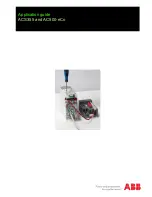
Page 14 of 90
CCT24
the channel busy a second time, the amount of time the radio will wait before checking the channel will
increase. It will continue to increase each subsequent time the channel is busy until the channel is finally
found idle. This is the classic CSMA technique that handles the situation where a number of radios hold
data to send at the same time. The
CSMA_ Predelay
parameter controls the maximum time that a radio
will wait before first listening to see if the channel is clear for a transmission. This parameter is used to
make sure that all the remotes do not transmit immediately after the base finishes transmitting.
CSMA (mode 1) provides classical CSMA channel access, and gives the user control over both the
CSMA_Predelay
and
CSMA_Backoff
parameters. This mode is well suited for large numbers of uncoordi-
nated radios, where periodic/event reporting is used, or tree-routing operation is required. In addition to
CSMA_ Predelay
and
CSMA_ MaxBackoff
, the user can set the
BaseSlotSize
and CSMA_
RemtSlotSize
parameters when using this mode. The following guidelines are suggested for setting
CSMA_Predelay
:
•
For lightly loaded CSMA contention networks, decrease
CSMA_Predelay
to 0x03 or less to reduce latency.
•
For heavily loaded CSMA contention networks, increase
CSMA_Predelay
to 0x05 or more for better throughput.
As an option, CSMA mode allows the base to directly track remotes entering and leaving the network, for
up to 126 remotes. The base is operated in protocol mode and is configured to send Announce messages
to its host when a remote joins, and when the remote’s registration lease expires.
While a base in a CSMA network can track a maximum of 126 remotes entering and leaving the network,
it can generate join Announce messages for an unlimited number of remotes. This allows the host appli-
cation to track remotes entering and leaving a CSMA network with more than 126 remotes by creating its
own table of MAC addresses and periodically sending a
GetRemoteRegister
command to each remote in
the table. Failure to answer a
GetRemoteRegister
command indicates the remote is no longer active in
the network.
CSMA modes work well in many applications, but CSMA has some limitations, as summarized below:
•
Bandwidth is not guaranteed to any remote.
•
Marginal RF links to some remotes can create a relatively high chance of
collisions in heavily loaded networks.
2.10.3 TDMA Modes
TDMA modes provide guaranteed bandwidth to some or all of the radios in a network. Radios that regis-
ter with the base receive several special parameters, including ranging information and a specific channel
access time slot assignment. TDMA registrations are always leased and must be renewed every 250
hops. The CCT24 provides three TDMA access modes, as discussed below.
TDMA Dynamic Slots (mode 2) is used for general-purpose TDMA applications where scaling the capaci-
ty per slot to the number of active remotes is automatic. Each radio that registers with the base receives
an equal time slice. As new remotes join, the size of the TDMA remote slots shrinks accordingly. The
number of slots, individual slot start times, and the
RemoteSlotSize
are computed automatically by the
CCT24 network in this mode. The user should note that the bandwidth to each remote will change















































